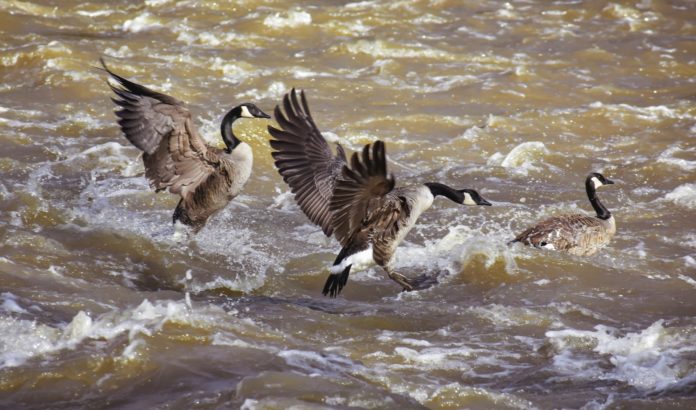Canada geese have a reputation for being pesky, and in some cases, they can cause major problems for the environment and our cities. Yet while many municipalities try to cope with this issue by harassing geese into leaving an area, a new study has found that when it comes to these iconic Canadian birds, traditional harassment techniques may be nothing more than a wild goose chase.
The study included contributions from Christopher Sharp, a population management biologist at Environment and Climate Change Canada, and was published in the Wildlife Society Bulletin.
In cities, Canada geese are often considered to be nuisance birds: they make messes of public areas and act aggressive towards people and animals, among other issues. Cities traditionally deal with their geese populations through harassment techniques, such as clacking boards together while walking towards them. The idea is that this harassing behaviour will force the geese to migrate to new locations — and that it will be most effective in the winter, when geese are already low on energy.
“The goal of harassment is never to hurt the geese,” explained Mike Ward, a professor in the Department of Natural Resources and Environmental Sciences at the University of Illinois and co-author of the study, in a press release.
Instead, Ward says the goal is “to get [the geese] to use up energy during an already tough season, forcing them to migrate to warmer climates.”
Along with the rest of their collaborators, Ward and Sharp were interested in learning just how effective these techniques really are. To do this, they fit Chicago-area geese with Fitbit-like GPS trackers in order to determine where the geese went after being harassed, and how the harassment affected their behaviour.
Surprisingly, the researchers found that harassing geese isn’t as effective as you might think. Canada geese returned to a given area two times faster on days when they were harassed compared to days when they were not.
Yet while this may seem unexpected, the researchers believe that their findings have to do with why geese were occupying a given area in the first place. When geese leave an area of their own accord, it’s likely because that area no longer has sufficient resources. On the other hand, harassed geese may return to an area because its resources (such as food, water, or shelter) are still beneficial to them.
“When they’re not being harassed, they’re making the choice to leave the park because it’s beneficial to them — there’s a resource elsewhere they want to access,” said Ryan Askren, a postdoctoral researcher at the University of Arkansas-Monticello and first author of the study.
“When we harass them, it causes them to leave momentarily, but more than likely they still have that drive to come back. So they’re returning more quickly, whereas the geese that leave in the absence of harassment are staying away to make use of a resource elsewhere.”
Canada geese are smart, adaptable birds, and this research suggests that municipalities need clever solutions if they want humans and geese to co-exist in peace.
While the authors suggest harassing geese in the coldest conditions, when they likely won’t have the energy to return after leaving an area, another option could be to focus on conserving their natural habitats. Doing so may help keep geese out of urban environments in the first place.









































